
Chernobyl or Chornobyl ) is a partially abandoned city in the Chernobyl Exclusion Zone, situated in the Vyshhorod Raion of northern Kyiv Oblast, Ukraine. Chernobyl is about 90 kilometres (60 mi) north of Kyiv, and 160 kilometres (100 mi) southwest of the Belarusian city of Gomel. Before its evacuation, the city had about 14,000 residents. While living anywhere within the Chernobyl Exclusion Zone is technically illegal today, authorities tolerate those who choose to live within some of the less irradiated areas, and around 1,000 people live in Pripyat today.
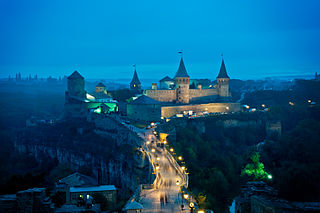
Podolia or Podilia is a historic region in Eastern Europe, located in the west-central and south-western parts of Ukraine and in northeastern Moldova.
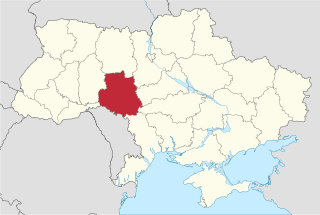
Vinnytsia Oblast, also referred to as Vinnychchyna, is an oblast in west-central Ukraine. Its administrative center is Vinnytsia. The oblast has a population of 1,509,515.
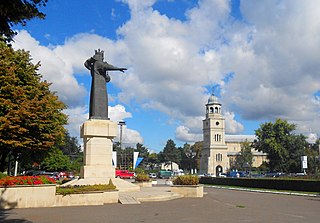
Bălți ) is a city in Moldova. It is the second largest city in terms of population, area and economic importance, after Chișinău. The city holds the status of municipiu. Sometimes called "the northern capital", it is a major industrial, cultural and commercial centre and transportation hub in the north of the country. It is situated 127 kilometres (79 mi) north of the capital Chișinău, and is located on the river Răut, a tributary of the Dniester, on a hilly landscape in the Bălți steppe.

Shpola is a city located in Zvenyhorodka Raion of Cherkasy Oblast (province) in central Ukraine. In May 2011, a 14-meter monument was installed on the outskirts of the city, claiming that Shpola is the geographical center of Ukraine. It hosts the administration of Shpola urban hromada, one of the hromadas of Ukraine. It had a population of 16,323

Bar is a town located on the Riv River in Vinnytsia Oblast, central Ukraine. It was the administrative center of the former Bar Raion until 2020, and is part of the historic region of Podolia. The town's estimated population is 15,337.
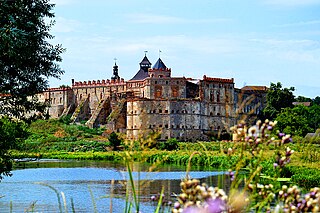
Medzhybizh, formerly Mezhybozhe, is an urban-type settlement in Khmelnytskyi Oblast, western Ukraine. It is located in Khmelnytskyi Raion, 25 kilometres from Khmelnytskyi on the main highway between Khmelnytskyi and Vinnytsia at the confluence of the Southern Buh and Buzhok rivers. Medzhybizh was once a prominent town in the former Podolia Province. Its name is derived from "mezhbuzhye", which means "between the Buzhenka Rivers". It is known as the birthplace of the Jewish Hasidic mystical religious movement. Medzhybizh hosts the administration of Medzhybizh settlement hromada, one of the hromadas of Ukraine. Current population: 1,237 ; 1,731,.

Bratslav is an urban-type settlement in Ukraine, located in Tulchyn Raion of Vinnytsia Oblast, by the Southern Bug river. It is a medieval European city and a regional center of the Eastern Podolia region founded by government of the Crown of the Kingdom of Poland, which dramatically lost its importance during the 19th-20th centuries. Population: 4,872
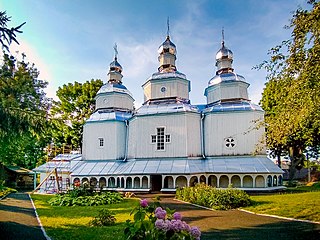
Vinnytsia ) is a city in western Ukraine, located on the banks of the Southern Bug. It serves as the administrative center of Vinnytsia Oblast. It is the largest city in the historic region of Podillia. It also serves as the administrative center of Vinnytsia Raion, one of the six raions of Vinnytsia Oblast. It has a population of 369,739.

Unity of Oleksandr Omelchenko, prior to 2020 Unity is a political party in Ukraine created in 1999 as a protest party. The party was led by the former mayor of Kyiv Oleksandr Omelchenko although in early 2008, he temporally halted his party membership in favor of a membership of Our Ukraine-Peoples Self Defence. Omelchenko died on November 25, 2021.

Bardejov Polish: Bardejów) is a town in North-Eastern Slovakia. It is situated in the Šariš region on a floodplain terrace of the Topľa River, in the hills of the Beskyd Mountains. It exhibits numerous cultural monuments in its completely intact medieval town center. The town is one of UNESCO's World Heritage Sites and currently maintains a population of about 32,000 inhabitants.
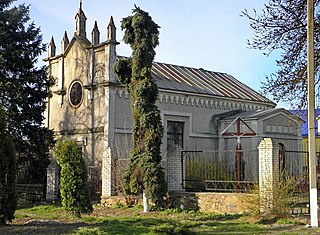
Bershad is a town in Vinnytsia Oblast, Ukraine, located in the historic region of Podolia. It was the administrative center of the former Bershad Raion until 2020. Population: 12,205.

Zhydachiv is a city in Stryi Raion, Lviv Oblast (region) in western Ukraine. It hosts the administration of Zhydachiv urban hromada, one of the hromadas of Ukraine. Local government is administered by the Zhydachivska city council. Its population is approximately 10,353 .
Vapniarka, also known as Vapniarca, Vapnyarka, Wapnjarka or Wapniarka, is an urban-type settlement in Tulchyn Raion, Vinnytsia Oblast, Ukraine, known since 1870 as a railroad station. Its name from the Ukrainian language translates as a lime (gypsum) settlement. As of January 2022 Vapniarka's population was approximately 7,165.

Sharhorod, also known as Shargorod, is a town located within the Vinnytsia Oblast, Ukraine. It serves as the administrative center of Sharhorod Raion, one of 33 regions of Vinnytsia Oblast. Population: 6,982

Mohyliv-Podilskyi is a city in Vinnytsia Oblast, Ukraine. It serves as the administrative center of Mohyliv-Podilskyi Raion within the oblast. It is located in the historic region of Podolia, on the border with Bessarabia, Moldova, along the left bank of the Dniester River. On the opposite side of the river lies the Moldovan town of Otaci, and the two municipalities are connected to each other by a bridge. Population: 29,925.
Tomashpil is an urban-type settlement in the eastern Podolia, specifically in Tulchyn Raion of Vinnytsia Oblast in central Ukraine. Tomashpil is situated on the banks of the Rusava River. Tomashpil is the administrative district of Tomashpil Raion (780 km2), home to 40.608 people scattered over the town and 30 villages around. Population: 5,276

The history of the Jews in Calabria reaches back over two millennia. Calabria is at the very south of the Italian peninsula, to which it is connected by the Monte Pollino massif, while on the east, south and west it is surrounded by the Ionian and Tyrrhenian seas. Jews have had a presence in Calabria for at least 1600 years and possibly as much as 2300 years. Calabrian Jews have had notable influence on many areas of Jewish life and culture. The Jews of Calabria are virtually identical to the neighbouring Jews of Sicily but are considered separate. However, the Jews of Calabria and the Jews of Apulia are historically the same community, only today are considered separate. Occasionally, there is confusion with the southern Jewish community in Calabria and the northern Jewish community in Reggio Emilia. Both communities have always been entirely separate.

The 2009–10 Ukrainian League Cup was the only season of Ukraine's football knockout competition designated for the members of the Ukrainian Second League and amateur clubs. The main purpose of this tournament was to supplement the 2009–2010 playing calendar of the Second League clubs whose number had declined remarkably triggering some talks of reforming the Ukrainian Second League. Currently amateur clubs are invited at the discretion of their respective regional football associations.

John-Paul Himka is an American-Canadian historian and retired professor of history of the University of Alberta in Edmonton. Himka received his BA in Byzantine-Slavonic Studies and Ph.D. in History from the University of Michigan in 1971 and 1977 respectively. The title of his Ph.D. dissertation was Polish and Ukrainian Socialism: Austria, 1867–1890. As a historian Himka was a Marxist in the 1970s–80s, but became influenced by postmodernism in the 1990s. In 2012 he defined his methodology in history as "eclectic".


















